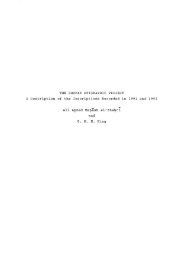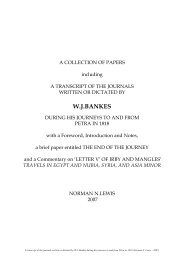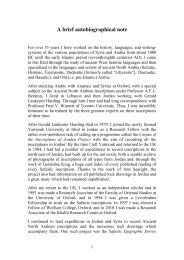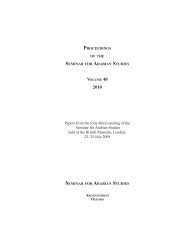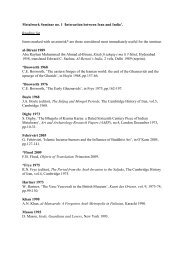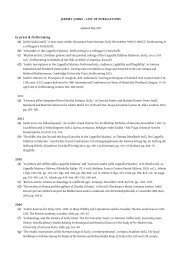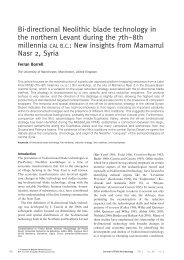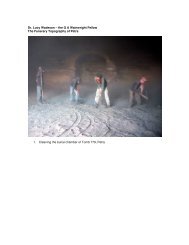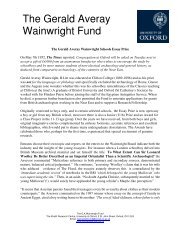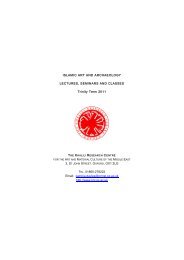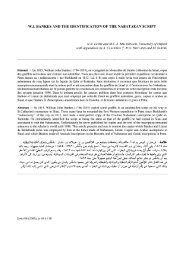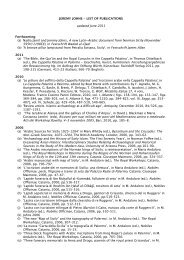Reflections on the linguistic map of pre-Islamic Arabia - Khalili ...
Reflections on the linguistic map of pre-Islamic Arabia - Khalili ...
Reflections on the linguistic map of pre-Islamic Arabia - Khalili ...
You also want an ePaper? Increase the reach of your titles
YUMPU automatically turns print PDFs into web optimized ePapers that Google loves.
180. In Safaitic, <strong>the</strong> verb $ s 1 lf almost always occurs in<br />
<strong>the</strong> c<strong>on</strong>text <strong>of</strong> a killing and a call for vengeance<br />
and, like its equivalent in Classical Arabic (see<br />
Lane 1408a-b), means ‘to do something (before<br />
<strong>the</strong> <strong>pre</strong>sent time) which requires requital (ei<strong>the</strong>r<br />
good or bad, at <strong>the</strong> <strong>pre</strong>sent time)’.<br />
181. The meaning <strong>of</strong> s 1 hw r here is not clear.<br />
182. See Macd<strong>on</strong>ald, The Form <strong>of</strong> <strong>the</strong> Definite Article;<br />
and Macd<strong>on</strong>ald, Old Arabic.<br />
183. See, for example, l-ys 2 rq l-mdbr ‘in order to migrate<br />
to <strong>the</strong> inner desert’ (LP 180); or w rdf h-dw $ n<br />
l-mdbr ‘he urged [ie. walked behind] <strong>the</strong> sheep<br />
towards <strong>the</strong> inner desert’ (WH 582).<br />
184. See Macd<strong>on</strong>ald MCA. North <strong>Arabia</strong>n Epigraphic<br />
Notes 1. AAE 3: 1992: 23–25.<br />
185. As opposed to Safaitic h-s 1 nt, in parallel<br />
c<strong>on</strong>texts (eg. C 1629, 1851, etc.). As in C 2446,<br />
<strong>the</strong> assimilati<strong>on</strong> <strong>of</strong> <strong>the</strong> n <strong>of</strong> <strong>the</strong> <strong>pre</strong>positi<strong>on</strong> mn<br />
is a feature <strong>of</strong> Safaitic, not Old Arabic.<br />
186. As opposed to h-s 1 fr, which is very comm<strong>on</strong> in<br />
this c<strong>on</strong>text. However, note that <strong>the</strong> assimilati<strong>on</strong><br />
<strong>of</strong> <strong>the</strong> n <strong>of</strong> <strong>the</strong> relative pr<strong>on</strong>oun mn is typical<br />
<strong>of</strong> Safaitic not Old Arabic. This text which was<br />
discovered by <strong>the</strong> Basalt Desert Rescue Survey<br />
is to be published by Dr. G.M.H. King, to whom<br />
I am most grateful for this informati<strong>on</strong>. On <strong>the</strong><br />
survey and its discoveries see, in <strong>the</strong> meantime,<br />
King GMH. The Basalt Desert Rescue Survey<br />
and Some Preliminary Remarks <strong>on</strong> <strong>the</strong> Safaitic<br />
Inscripti<strong>on</strong>s and Rock Drawings. PSAS 20: 1990:<br />
55–78.<br />
187. See Macd<strong>on</strong>ald, The Form <strong>of</strong> <strong>the</strong> Definite Article.<br />
Winnett and Harding translate w-bny $ rgm<br />
in WH 234 as ‘he built <strong>the</strong> cairn’ and cite this<br />
as an example <strong>of</strong> a definite article $ -. However,<br />
it is more likely that $ rgm is <strong>the</strong> plural <strong>of</strong> rgm<br />
and <strong>the</strong> sentence means ‘and he built some<br />
cairns’. Winnett also finds a supposed $ - article<br />
in WAMS 11 which he reads lyrbnghw r $ -g{m}l<br />
‘By Yr s<strong>on</strong> <strong>of</strong> Ghw r is <strong>the</strong> camel’. But it is clear<br />
from <strong>the</strong> photograph that <strong>the</strong> text has been tampered<br />
with and that <strong>the</strong> supposed $ was originally<br />
written as a h, <strong>the</strong> lower side stroke<br />
(which turned it into a $ )beingaddedbyadifferent<br />
hand.<br />
188. HCH 193ΩHSIM 49218b (provenance unknown)<br />
... fdt $ b-hw gr.<br />
189. Naturalis Historia 32.157.<br />
190. See Drewes, The Ph<strong>on</strong>emes <strong>of</strong> Lihyanite: 167–<br />
168; and <strong>the</strong> discussi<strong>on</strong> above.<br />
191. See for example JSLih 75/2, HE 2, Stiehl R. Neue<br />
lihw yānische Inschriften aus al- c Udaib. I. Mit<br />
einem Nachtrag M. Höfners. In: Al<strong>the</strong>im F &<br />
Stiehl R, eds. Christentum am Roten Meer. 1. Berlin:<br />
de Gruyter, 1971: 23 and 32, nos A18/2 and D5/<br />
THE LINGUISTIC MAP OF PRE-ISLAMIC ARABIA<br />
3, respectively. The ex<strong>pre</strong>ssi<strong>on</strong> d $ l appears to<br />
occur in JSLih 226. However, this number covers<br />
two separate inscripti<strong>on</strong>s. The first (c<strong>on</strong>sisting <strong>of</strong><br />
line 1) is in <strong>the</strong> late Dadanitic script and appears<br />
to read grms 2 ll. The sec<strong>on</strong>d (c<strong>on</strong>sisting <strong>of</strong> lines 2–<br />
3) is in <strong>the</strong> South <strong>Arabia</strong>n script (note <strong>the</strong> forms<br />
<strong>of</strong> $ and d) and clearly reads d $ l //bny. Jaussen and<br />
Savignac treat <strong>the</strong> clan or family name as $ l-bny,<br />
ie. with $ l- re<strong>pre</strong>senting <strong>the</strong> Arabic definite article,<br />
and this is possible. However, <strong>the</strong>ir comparis<strong>on</strong><br />
<strong>of</strong> this with <strong>the</strong> ethnic<strong>on</strong> bnyn (ie. with <strong>the</strong><br />
Sayhadic article -n) in CIH 287/7–8, is inappropriate<br />
since, in <strong>the</strong> latter text, bn-y is a nisba form<br />
and this is <strong>the</strong> reas<strong>on</strong> that it has <strong>the</strong> article (ie.<br />
bn-y- n ‘<strong>the</strong> Bn-ite’). In JSLih 226, <strong>on</strong> <strong>the</strong> o<strong>the</strong>r<br />
hand, $ l follows d and so, if it is <strong>the</strong> definite article,<br />
it must be part <strong>of</strong> <strong>the</strong> name (as it is in <strong>the</strong><br />
‘tribal’ name which occurs in <strong>the</strong> forms hn- $ hw nkt<br />
and $ l- $ hw nkt). It is clear that <strong>the</strong> two parts <strong>of</strong> JSLih<br />
226 do not bel<strong>on</strong>g toge<strong>the</strong>r and it seems probable<br />
that at least lines 2–3 are part <strong>of</strong> a text <strong>the</strong> beginning<br />
<strong>of</strong> which is lost.<br />
192. That is, in <strong>the</strong> Gh<strong>on</strong>eim inscripti<strong>on</strong> discussed<br />
earlier (see Kropp, The Inscripti<strong>on</strong> Gh<strong>on</strong>eim;<br />
and Robin, L’Arabie antique: 114–115) and in<br />
<strong>the</strong> Sabaeo-North-<strong>Arabia</strong>n inscripti<strong>on</strong> <strong>of</strong><br />
unknown provenance, CIH 450/ 2–3 in relati<strong>on</strong><br />
to a woman: dt / $ l / $ l / $ hw nkt, and in lines 5–<br />
6 in relati<strong>on</strong> to a man: d- $ l / $ l / $ l- $ hw nkt. The<br />
word divisi<strong>on</strong> suggests that <strong>the</strong> (<strong>pre</strong>sumably<br />
Sabaeo-ph<strong>on</strong>e) engraver was unaware <strong>of</strong> <strong>the</strong> literal<br />
meaning <strong>of</strong> <strong>the</strong> ANA ex<strong>pre</strong>ssi<strong>on</strong> d $ l or <strong>of</strong><br />
<strong>the</strong> significance <strong>of</strong> <strong>the</strong> Old Arabic article $ l.Having<br />
correctly separated dt and $ l in lines 2–3 he<br />
seems to have assumed that d $ l in line 5 was <strong>the</strong><br />
masculine form <strong>of</strong> dt, and so treated it as a<br />
single word, and <strong>the</strong>n repeated <strong>the</strong> pattern <strong>of</strong><br />
two $ l’s between this and $ hw nkt. On <strong>the</strong> o<strong>the</strong>r<br />
hand, having incorrectly separated <strong>the</strong> definite<br />
article $ l- from $ hw nkt in line 3, he correctly joined<br />
<strong>the</strong> two in line 6.<br />
193. See for instance Robin, L’Arabie antique: 114–<br />
115; Robin, IIS. 1: 54–55.<br />
194. In Kāfir 10 (Robin, IIS. 1: 135); Kamna 11/2 (ibid.<br />
181); RES 4133/6; and Ryckmans, Graffites sabéens:<br />
560.<br />
195. In Haram 33 and 36 (Robin, IIS. 1: 101–102 and<br />
104–105 respectively).<br />
196. In Ry 455/2 (Ryckmans G. Inscripti<strong>on</strong>s sudarabes.<br />
Neuvième série [Ry 444–498]. Le Musé<strong>on</strong><br />
64: 1951: 111), CIH 534/2, RES 4663/2, Haram<br />
53 (Robin, IIS. 1: 122–123).<br />
197. Note that <strong>the</strong>re is no case <strong>of</strong> *d- $ hw nkt n which<br />
would be <strong>the</strong> true equivalent <strong>of</strong> d $ l hn- $ hw nkt/d<br />
$ l $ l- $ hw nkt.<br />
77



